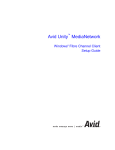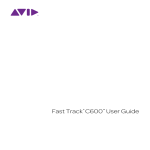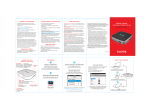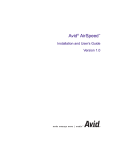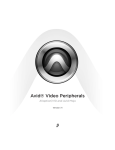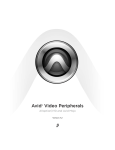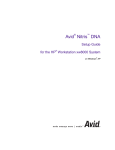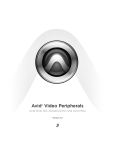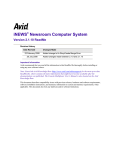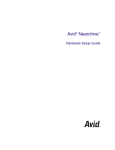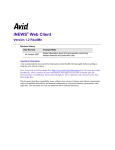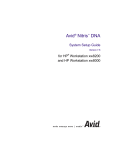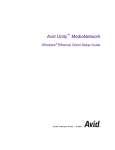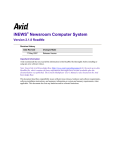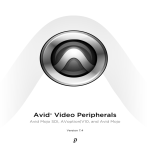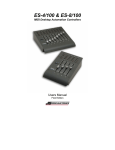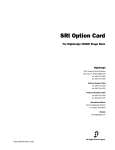Download Using the Avid Nitris - Used Broadcast Equipment
Transcript
a Using the Avid Nitris Important Information Avid® recommends that you read all the information in these installation instructions thoroughly before connecting or using your new hardware and software. This document explains how to use and to connect cables and devices to the Avid Nitris™ Digital Nonlinear Accelerator (DNA) and how to connect specific devices to an Avid-supported system to which the Avid Nitris is connected. Avid-supported systems for your Avid Nitris can change at any time. n Make sure to look at the ReadMe file that installs with the application. It contains important information that is used in conjunction with the information presented in this document. Contents If You Need Help . . . . . . . . . . . . . . . . . . . . . . . . . . . . . . . . . . . . . . . . . . . . . . . . . . . . . . . . . . 3 Symbols and Conventions. . . . . . . . . . . . . . . . . . . . . . . . . . . . . . . . . . . . . . . . . . . . . . . . . . . 4 Overview . . . . . . . . . . . . . . . . . . . . . . . . . . . . . . . . . . . . . . . . . . . . . . . . . . . . . . . . . . . . . . . . 4 Site Planning . . . . . . . . . . . . . . . . . . . . . . . . . . . . . . . . . . . . . . . . . . . . . . . . . . . . . . . . . . . . . 5 Environmental Requirements . . . . . . . . . . . . . . . . . . . . . . . . . . . . . . . . . . . . . . . . . . . . . 6 Electrical Requirements . . . . . . . . . . . . . . . . . . . . . . . . . . . . . . . . . . . . . . . . . . . . . . . . . 6 Rack Mounting the Avid Nitris Enclosure . . . . . . . . . . . . . . . . . . . . . . . . . . . . . . . . . . . . . . . 7 Equipment Environmental and Safety Guidelines . . . . . . . . . . . . . . . . . . . . . . . . . . . . . 8 Installing the Avid Nitris in a Rack . . . . . . . . . . . . . . . . . . . . . . . . . . . . . . . . . . . . . . . . . 8 Positioning the Avid Nitris in the Rack . . . . . . . . . . . . . . . . . . . . . . . . . . . . . . . . . . . 8 Securing the Avid Nitris in a Rack . . . . . . . . . . . . . . . . . . . . . . . . . . . . . . . . . . . . . 10 Avid Nitris Front Indicators and Rear Connectors . . . . . . . . . . . . . . . . . . . . . . . . . . . . . . . . 12 Front Panel . . . . . . . . . . . . . . . . . . . . . . . . . . . . . . . . . . . . . . . . . . . . . . . . . . . . . . . . . . 12 Rear Panel. . . . . . . . . . . . . . . . . . . . . . . . . . . . . . . . . . . . . . . . . . . . . . . . . . . . . . . . . . 14 HD Video I/O Board Connectors. . . . . . . . . . . . . . . . . . . . . . . . . . . . . . . . . . . . . . 15 Eight-Channel Audio I/O Board Connectors . . . . . . . . . . . . . . . . . . . . . . . . . . . . . 16 SD Video I/O Board Connectors . . . . . . . . . . . . . . . . . . . . . . . . . . . . . . . . . . . . . . 18 Workstation Overview. . . . . . . . . . . . . . . . . . . . . . . . . . . . . . . . . . . . . . . . . . . . . . . . . . . . . 20 HP Workstation xw8200 Slot Configuration and Connections. . . . . . . . . . . . . . . . . . . 20 Avid Nitris Base Board Connection . . . . . . . . . . . . . . . . . . . . . . . . . . . . . . . . . . . . . . . 22 Connecting the Avid Nitris . . . . . . . . . . . . . . . . . . . . . . . . . . . . . . . . . . . . . . . . . . . . . . 23 Connecting the Keyboard and Mouse . . . . . . . . . . . . . . . . . . . . . . . . . . . . . . . . . . . . . 24 Connecting the Monitors . . . . . . . . . . . . . . . . . . . . . . . . . . . . . . . . . . . . . . . . . . . . . . . 25 Connecting the Application Key. . . . . . . . . . . . . . . . . . . . . . . . . . . . . . . . . . . . . . . . . . 26 Connecting the SCSI Local Storage Systems . . . . . . . . . . . . . . . . . . . . . . . . . . . . . . . . . . 26 Avid MediaDock Ultra320 . . . . . . . . . . . . . . . . . . . . . . . . . . . . . . . . . . . . . . . . . . . . . . 27 Formatting and Striping Media Drives . . . . . . . . . . . . . . . . . . . . . . . . . . . . . . . . . . . . . 29 Avid Unity Environment . . . . . . . . . . . . . . . . . . . . . . . . . . . . . . . . . . . . . . . . . . . . . . . . . . . 30 Reference Signal . . . . . . . . . . . . . . . . . . . . . . . . . . . . . . . . . . . . . . . . . . . . . . . . . . . . . . . . 31 Sync Topology . . . . . . . . . . . . . . . . . . . . . . . . . . . . . . . . . . . . . . . . . . . . . . . . . . . . . . . 31 Tri-level Sync . . . . . . . . . . . . . . . . . . . . . . . . . . . . . . . . . . . . . . . . . . . . . . . . . . . . . . . . 32 Black Burst Sync . . . . . . . . . . . . . . . . . . . . . . . . . . . . . . . . . . . . . . . . . . . . . . . . . . . . . 32 Connecting Audio and Video Equipment . . . . . . . . . . . . . . . . . . . . . . . . . . . . . . . . . . . . . . 32 Connecting Video . . . . . . . . . . . . . . . . . . . . . . . . . . . . . . . . . . . . . . . . . . . . . . . . . . . . 33 Connecting a Video Deck — Component Signal . . . . . . . . . . . . . . . . . . . . . . . . . 34 Connecting a Video Deck — Composite Signal . . . . . . . . . . . . . . . . . . . . . . . . . . 36 Connecting a Video Deck — Serial Digital Signal. . . . . . . . . . . . . . . . . . . . . . . . . 37 Connecting a Video Deck — S-Video Signal . . . . . . . . . . . . . . . . . . . . . . . . . . . . 38 Controlling a Video Deck . . . . . . . . . . . . . . . . . . . . . . . . . . . . . . . . . . . . . . . . . . . 39 Connecting Audio . . . . . . . . . . . . . . . . . . . . . . . . . . . . . . . . . . . . . . . . . . . . . . . . . . . . 40 Connecting a Client Monitor . . . . . . . . . . . . . . . . . . . . . . . . . . . . . . . . . . . . . . . . . . . . 42 Qualified VGA Outputs . . . . . . . . . . . . . . . . . . . . . . . . . . . . . . . . . . . . . . . . . . . . . . . . 42 Connecting Serial and MIDI Port Devices . . . . . . . . . . . . . . . . . . . . . . . . . . . . . . . . . . . . . 43 USB and Serial Connections . . . . . . . . . . . . . . . . . . . . . . . . . . . . . . . . . . . . . . . . . . . . 43 Connecting the USB Hub. . . . . . . . . . . . . . . . . . . . . . . . . . . . . . . . . . . . . . . . . . . . . . . 43 Connecting the USB Devices to the USB Hub . . . . . . . . . . . . . . . . . . . . . . . . . . . . . . 44 2 If You Need Help Connecting the USB-to-Serial Adapter . . . . . . . . . . . . . . . . . . . . . . . . . . . . . . . . . 45 Connecting the USB-to-MIDI Converter . . . . . . . . . . . . . . . . . . . . . . . . . . . . . . . . 45 Connecting JL Cooper Fader Controllers . . . . . . . . . . . . . . . . . . . . . . . . . . . . . . . . . . . 46 Connecting the Yamaha 01V/96 Mixer. . . . . . . . . . . . . . . . . . . . . . . . . . . . . . . . . . . . . 48 Installing and Removing the Avid Fan. . . . . . . . . . . . . . . . . . . . . . . . . . . . . . . . . . . . . . . . . 50 Regulatory and Safety Notices . . . . . . . . . . . . . . . . . . . . . . . . . . . . . . . . . . . . . . . . . . . . . . 52 Warnings and Cautions . . . . . . . . . . . . . . . . . . . . . . . . . . . . . . . . . . . . . . . . . . . . . . . . 52 FCC Notice . . . . . . . . . . . . . . . . . . . . . . . . . . . . . . . . . . . . . . . . . . . . . . . . . . . . . . . . . . 52 Canadian ICES-003 . . . . . . . . . . . . . . . . . . . . . . . . . . . . . . . . . . . . . . . . . . . . . . . . . . . 52 European Union Notice . . . . . . . . . . . . . . . . . . . . . . . . . . . . . . . . . . . . . . . . . . . . . . . . 53 Disposal of Waste Equipment by Users in the European Union . . . . . . . . . . . . . . . . . . . . . 55 Australia and New Zealand EMC Regulations . . . . . . . . . . . . . . . . . . . . . . . . . . . . . . . 56 Taiwan EMC Regulations . . . . . . . . . . . . . . . . . . . . . . . . . . . . . . . . . . . . . . . . . . . . . . . 56 Technical Support Information . . . . . . . . . . . . . . . . . . . . . . . . . . . . . . . . . . . . . . . . . . . . . . 56 If You Need Help If you are having trouble using Avid Nitris: 1. Retry the action, carefully following the instructions given for that task. It is especially important to check each step of your workflow. 2. Check the ReadMe file for the latest information that might have become available after the documentation was published. Also check online for the most up-to-date ReadMe because the online version is updated whenever new information becomes available. To view the online ReadMe, select ReadMe from the Help menu, or visit the Knowledge Base at www.avid.com/readme. 3. Check the documentation that came with your Avid application or your hardware for maintenance or hardware-related issues. 4. Visit Avid Online Support at www.avid.com/onlineSupport/. Online support is available 24 hours per day, 7 days per week. Search the Knowledge Base to find answers, to view error messages, to access troubleshooting tips, to download updates, and to read or join online message-board discussions. 3 Symbols and Conventions These installation instructions use the following symbols and conventions: Symbol or Convention Meaning or Action n A note provides important related information, reminders, recommendations, and strong suggestions. c A caution means that a specific action you take could cause harm to your computer or cause you to lose data. w A warning describes an action that could cause you physical harm. Follow the guidelines in this document or on the unit itself when handling electrical equipment. > This symbol indicates menu commands (and subcommands) in the order you select them. For example, File > Import means to open the File menu and then select the Import command. t This symbol indicates a single-step procedure. Multiple arrows in a list indicate that you perform one of the actions listed. Italic font Italic font is used to emphasize certain words and to indicate variables. Courier Bold font Courier Bold font identifies text that you type. Ctrl+key or mouse action Press and hold the first key while you press the last key or perform the mouse action. For example, Ctrl+drag. Overview The Avid Nitris is designed to capture and output analog and serial digital media using decks, cameras, and audiotapes. The Avid Nitris is powered by an autosensing power supply connected by a standard power cord to a wall plug or power strip. The Avid Nitris accepts video and audio in different formats and resolutions, and changes these formats and resolutions to Avid-specific data for transfer to the Avid editing system over a Digital Interlink cable. The data transfer uses an Avid-specific protocol that describes the format and resolution of the media being captured. You then edit the media on the Avid editing system and send it back to the Avid Nitris. You can change the format and resolution as needed for video and audio output. 4 Site Planning The Avid Nitris consists of: • The Avid Nitris enclosure, backplane, power supply, and power cord • A standard-definition (SD) video I/O board • A high-definition (HD) video I/O board • A eight-channel audio I/O board Three audio cables are provided with the Avid Nitris; analog in, analog out, and AES/EBU I/O. The audio cables have a DB25 connector at one end that plugs into the Avid Nitris and the other end of the cables have eight separate XLR connectors supporting eight channels of audio. For more information, see “Connecting Audio” on page 40. The Avid Nitris is shipped with the Using the Avid Nitris CD-ROM that includes this online document. Site Planning When preparing your site, you must consider the environmental, electrical, and space requirements for your Avid Nitris workstation, as well as any additional equipment. Before setting up your system, see the ReadMe provided with the Avid editing application to make sure that there are no changes to the information in this document. The required expansion boards are installed and configured for Avid Nitris. Do not remove or modify these boards. For instructions on setting up the computer hardware, see the setup documentation provided with the HP Workstation. For a rackmount workstation, you must install the computer into a standard rack before connecting the hardware. To prevent equipment damage that may be caused by static electricity, do all of the following before making any connections: • Turn off all devices. • Always use anti-static prevention. • Always connect devices to a properly grounded outlet. • Touch the metal casing of the device before handling any circuit boards. 5 Environmental Requirements The site you choose for your Avid Nitris workstation should meet the following environmental requirements: • Clean and dust free • Free from significant temperature or humidity changes • Sturdy, level, and not subject to vibration • Away from radio frequency emissions, high-traffic, or high-noise areas • Provides adequate space in front of and behind the workstation components, so that you can connect cables and service your workstation. This also provides adequate airflow for cooling. • A minimum clearance of 3 inches (7.6 cm) for the side and back panels of the deskside base unit • A table (or other surface) that is at least 60 inches wide by 48 inches deep (150 cm × 120 cm) for the editing workstation Electrical Requirements Your site should meet the following electrical requirements: n 6 • Adequate power for each workstation component, so that extension cords are not needed. • At least two 15-amp circuits available: one for the workstation, Nitris, and accessories and one for the Avid MediaDock storage system. • Site is away from major electrical equipment, such as motors, air conditioners, or elevators. • Site is not subject to static electrical buildup. • Uses an uninterruptible power supply (UPS) to protect your workstation from sudden power surges or losses, and to save you from the resulting loss of work. Plug only your Avid Nitris equipment into the power strip. Do not plug in coffee makers, radios, lights, or other such devices. Rack Mounting the Avid Nitris Enclosure The following table describes the electrical specifications for the Avid Nitris editing system. Electrical Specifications Component Voltage Frequency HP Workstation xw8200 100 to 240 V ac auto-ranging 50 to 60 Hz Avid Nitris 100 to 240 V ac 50 to 60 Hz Avid MediaDock Ultra320 storage systems 90 to 264 V ac 50 to 60 Hz The following table lists the dimensions of the major hardware components. Hardware Component Dimensions Dimensions (Inches) Dimensions (Centimeters) HP Workstation xw8200 Rackmount configuration — Rack Units: 5 Height: 17.9 Depth: 20.7 Width: 8.3 Height: 45.4 Depth: 52.5 Width: 21.0 Avid Nitris Rackmount configuration — Rack Units: 3 Height: 5.3 Width: 17.6 Depth: 13 Height: 13.5 Width: 44.7 Depth: 33.02 Hardware component Rack Mounting the Avid Nitris Enclosure This section provides the information for mounting the Avid Nitris in a 19-inch (483-mm) National Electrical Manufacturers Association (NEMA) or Electronics Industries Association (EIA) rack. Avid recommends that you mount your Avid Nitris in a rack before you connect any cables. n If you need to rack mount the HP workstation, a rack-mount kit is available from HP. Installation instructions are included with the kit. The HP Workstation system requires 5 rack units. See the following sections for more information: • Equipment Environmental and Safety Guidelines • Installing the Avid Nitris in a Rack 7 Equipment Environmental and Safety Guidelines When you install the Avid Nitris in a rack, you must take the following precautions: • Elevated Operating Ambient Temperature — When the Avid Nitris is installed in a closed or multiunit rack assembly, the operating ambient temperature of the rack environment might be greater than the room ambient temperature. Therefore, consider installing the equipment compatible with the manufacturer’s maximum ambient temperature of 104°F (40°C). • Reduced Airflow — Do not compromise the amount of airflow required for safe operation of the equipment. • Mechanical Loading — Avoid a hazardous condition due to an uneven mechanical loading. • Circuit Overloading — Consider connecting the equipment to the supply circuit and the effect that overloading of circuits might have on overcurrent protection and supply wiring. Use appropriate equipment nameplate ratings. • Reliable Earthing — Maintain reliable earthing of rack-mount equipment. Give particular attention to supply connections other than direct connections to the branch circuit (for example, the use of power strips). Installing the Avid Nitris in a Rack The Avid Nitris is designed for 19-inch (483-mm) rack enclosures and requires three EIA rack units (3U), or 5 ¼ inches (133.4 mm) of rack space. The Avid Nitris is shipped with rack-nut clips for those rack enclosures that do not have threaded holes. Rack-nut clips are clipped in the holes of the rack that are used to secure the rack components in place. w To ensure the stability of the rack enclosure, start from the bottom when you install the rack components in the rack enclosure. Positioning the Avid Nitris in the Rack The following procedure helps you decide where to install the Avid Nitris in the rack. If your rack enclosure does not have threaded holes, install the rack-nut clips included with the Avid Nitris where the Avid Nitris front panel secures to the rack enclosure. If your rack enclosure has threaded holes, do not attach the rack-nut clips. 8 Rack Mounting the Avid Nitris Enclosure To position the Avid Nitris in the rack enclosure and attach the rack-nut clips: 1. Select the lowest position in the rack where you can mount the Avid Nitris. Position the Avid Nitris so the bottom is at the baseline of a U-alignment position. If your rack enclosure has threaded holes, continue with “Securing the Avid Nitris in a Rack” on page 10. Positioning the Avid Nitris Rack mounting rail 5/8 in Rack mounting rail hole spacing 5/8 in 1/2 in 5/8 in 1 3/4 in 3U 5/8 in 1/2 in 5/8 in 1 3/4 in 2U Avid Nitris 5/8 in 1/2 in 1 3/4 in 1U 5/8 in 5/8 in EIA rack unit 1/2 in Baseline of Avid Nitris is at U-alignment position between two 1/2-inch holes. 9 2. From the inside of the enclosure rail, slide the rack-nut clip over each hole you want to use. Each front support rail needs 2 rack-nut clips for the front of the Avid Nitris. Attaching Rack-Nut Clips onto the Rack Enclosure Rack-nut clip slid over hole Rack enclosure mounting rail Securing the Avid Nitris in a Rack The Avid Nitris is secured in the front mounting rails of the rack with four rackmount screws. If your rack has threaded holes, use the proper rack screws for your rack. If your rack does not have threaded holes, attach the rack-nut clips included with the Avid Nitris as previously described (see “Positioning the Avid Nitris in the Rack” on page 8). c 10 You should have someone helping you to lift the Avid Nitris enclosure. Rack Mounting the Avid Nitris Enclosure To secure the Avid Nitris into the rack. 1. From the front of the rack, position the Avid Nitris so that it is flush against the front mounting rails. Installing an Avid Nitris Front mounting rail a 16 15 14 0 13 -6 12 11 -18 -42 8 3 10 0 7 6 5 4 IN 9 -6 -18 -42 2 1 SD I A AN DIG LL PU WN DO HD F RE A AN SD F RE LTC T OU CK LO SD HD EO VID ris Nit Screws 2. Align the holes in the Avid Nitris with the holes in the front mounting rail. From the front of the rack enclosure, insert the screws through the Avid Nitris and front mounting rail, and tighten. 11 Avid Nitris Front Indicators and Rear Connectors The Avid Nitris provides the high definition and standard definition input and output for your Avid editing system. The front panel of the Avid Nitris has several status LEDs, audio meters, and a power button. n Turn on the Avid Nitris after you have turned on your computer. Front Panel The following figure shows the front panel of the Avid Nitris. The table following the figure describes the Avid Nitris LEDs and power button. Avid Nitris Front Panel Status LEDs Audio meters a 0 -6 IN Nitris HD SD HD SD ANA REF REF LOCK PULL DOWN LTC DIG SDI -18 ANA -42 1 2 3 4 5 6 7 8 9 10 11 12 13 14 15 16 VIDEO 0 OUT -6 -18 -42 Power button Power LEDs LEDs Avid Nitris LEDs LED Status When Lit VIDEO HD The LED is illuminated in High Definition (HD) mode (as opposed to SD). Lit when the application is set to capture HD source media and the signal is present from the source. SD The LED is illuminated in Standard Definition (SD) mode. Lit when the application is set to capture SD source media and the signal is present from the source. 12 Avid Nitris Front Indicators and Rear Connectors Avid Nitris LEDs (Continued) LED Status When Lit ANA Lit when the application is set to capture an analog video input and the signal is present. The ANA and SD LEDs are always lit when the system is capturing analog SD video. n Avid Nitris does not capture analog HD so the ANA does not light during an HD capture. HD REF Blinks when a High Definition Reference signal is connected and constantly on when the Nitris is locked to the incoming Reference signal. SD REF Blinks when a Standard Definition Reference signal is connected and constantly on when the Avid Nitris is locked to the incoming Reference signal. Lock Lit when a valid reference input signal is present and locked (for capture). Blinks if the sync signal is not valid. AUDIO Pull Down Lit when audio Pulldown is selected in the application during capture. LTC Lit when LTC IN is present on the input to the Avid Nitris. DIG Lit when a digital input is selected in the application. SDI Lit when a serial digital input is selected in the application. ANA Lit when an analog input is selected in the application. Power LEDs LEDs around the power button light when the Avid Nitris is on. Yellow is displayed when no signal is detected from the Nitris Base board. Green is displayed when the Nitris Base board signal is detected. 13 Rear Panel The Avid Nitris rear panel contains the following video I/O and audio I/O boards: • HD Video I/O board — Provides HD SDI I/O, HD monitor, HD component, and HD tri-level sync connections for video equipment. • Eight-channel audio I/O board — Provides two microphone inputs, eight analog I/O channels, two S/PDIF audio I/O channels, eight AES/EBU audio I/O channels, and eight channels of optical ADAT. • SD Video I/O board — Provides analog and digital I/O connections for video equipment, and connects the Avid Nitris to the system using the digital interlink cable. Digital interlink cable transfers video signal data between the workstation’s Avid Nitris Base board and the Avid Nitris. The SD Video I/O board also provides a connection for syncing equipment to the Avid Nitris. Avid Nitris Rear Panel HD video I/O board HD SDI IN HD SDI OUT OUT 1 Eight-channel audio I/O board HD COMPONENT OUT HD MONITOR OUT OUT 2 Y NITRIS HD ANALOG AUDIO IN ANALOG AUDIO OUT GAIN GAIN S/P DIF MIC 2 1 2 3 4 5 6 7 8 1 2 3 4 5 6 7 Y PB PR CV S-VIDEO Y PB PR OPTICAL IN OUT 8 SDI CV 1 SD SYNC AES/EBU IN/OUT OUT ANALOG OUT S-VIDEO HD TRILEVEL SYNC DAE OUT 1 IN LTC 1 SYSTEM CV 2 OUT 2 IN SD video I/O board n OUT 2 MONITOR OUT ANALOG IN PR DIGITAL AUDIO IN MIC 1 PB Power cord connector If you select a downconvert format, you can output HD playback and SD downconvert simultaneous through the Avid Nitris. As a result, you can monitor SD output or create an SD master at the same time you are outputting an HD master. Some HD media formats are not compatible with SD resized outputs. Each connector on the three Avid Nitris I/O boards is described in the following sections: HD Video I/O Board Connectors Eight-Channel Audio I/O Board Connectors SD Video I/O Board Connectors 14 Avid Nitris Front Indicators and Rear Connectors HD Video I/O Board Connectors The following figure shows the connections on the HD video I/O board. The following table describes the function of each connector. You select which inputs to use from the Capture tool when inputting. n The HD Monitor and HD Component outputs cannot be used at the same time. Select one of the two in the Output tool. HD Video I/O Board Connectors 1 2 HD SDI IN 3 4 HD SDI OUT OUT 1 OUT 2 5 HD MONITOR OUT NITRIS HD 6 7 8 HD COMPONENT OUT Y PB PR HD TRILEVEL SYNC HD Video I/O Board Identifiers Number Label Function 1 HD SDI IN High-definition Serial Digital Interface input, BNC connector. 2 HD SDI OUT 1 High-definition Serial Digital Interface output number 1, BNC connector. 3 HD SDI OUT 2 High-definition Serial Digital Interface output number 2, BNC connector. 4 HD MONITOR OUT High-definition component analog RGB video signal on a 15-pin connector: compatible with multisync computer monitors. n The HD MONITOR OUT connector on the HD Video I/O Board provides an output signal to VGA monitors. PAL video does not work because 50 Hertz (Hz) is not available in VGA monitors although, some 48 Hz monitors might display 24p. NTSC and HD video over 59 Hz usually works with a 60 Hz refresh rate. Video with a refresh rate higher than 60 Hz usually displays at one of the available monitor refresh rates. 5 HD COMPONENT OUT, Y HD analog component video output, Y color difference signal, BNC connector; connects to analog video input of a monitor or waveform /vectorscope. 6 HD COMPONENT OUT, PB HD analog component video output, PB color difference signal, BNC connector; connects to analog video input of a monitor or waveform /vectorscope. 15 HD Video I/O Board Identifiers (Continued) Number Label Function 7 HD COMPONENT OUT, PR HD analog component video output, PR color difference signal, BNC connector; connects to analog video input of a monitor or waveform /vectorscope. 8 HD TRILEVEL SYNC High-definition video reference input for tri-level sync. Eight-Channel Audio I/O Board Connectors The following figure shows the connections on the eight-channel audio I/O board. The following table describes the function of each connector. You select which audio inputs to use from the Capture tool when inputting. Eight-Channel Audio I/O Board Connectors Gain adjustments ANALOG AUDIO IN S/P DIF ANALOG AUDIO OUT DIGITAL AUDIO IN GAIN MIC 1 MIC 2 1 1 2 2 3 4 5 3 GAIN 6 7 8 1 2 3 4 4 5 AES/EBU IN/OUT OUT 6 7 OPTICAL IN OUT 8 5 6 7 8 9 Eight-Channel Audio I/O Board Identifiers Number Label Function 1 MIC 1 2 MIC 2 Microphone (MIC) inputs, two female XLR connectors. The analog microphone connectors accept powered or 48 V phantom power microphones. The audio input and microphone are selected in the software. 3 ANALOG IN Channels 1 - 8 Professional level audio input, 25-pin DSUB connector; a color coded DB25 to XLR cable is provided. — Gain Gain controls for the 8 audio inputs. 4 ANALOG OUT Channels 1 - 8 Professional level audio output, 25-pin DSUB connector; a color coded DB25 to XLR cable is provided. — Gain Gain controls for the 8 audio outputs. 16 Avid Nitris Front Indicators and Rear Connectors Eight-Channel Audio I/O Board Identifiers (Continued) Number Label Function 5 S/PDIF IN S/PDIF digital input, white phono (RCA) jack. 6 S/PDIF OUT S/PDIF digital output, red phono (RCA) jack. 7 AES/EBU IN/OUT Channels 1 - 8 AES/EBU digital input and output, 25-pin DSUB-connector; a color coded DB25 to XLR cable is provided. 8 OPTICAL IN 8 optical channels input. 9 OPTICAL OUT 8 optical channels output. 17 SD Video I/O Board Connectors The following figure shows the connections on the SD video I/O board. The following table describes the function of each connector. You select which inputs to use from the Capture tool when inputting. SD Video I/O Board Connectors 10 SDI ANALOG OUT CV 1 SD SYNC Y PB PR CV S-VIDEO Y PB PR S-VIDEO 20 16 DAE LTC OUT 1 IN 1 SYSTEM CV 2 OUT 2 1 2 3 4 5 6 7 8 9 11 12 13 IN 15 17 OUT 18 2 19 MONITOR OUT ANALOG IN 14 21 All analog video outputs are available during capture and playback to be used as a client monitor. SD Video I/O Board Identifiers Number Label Function 1 SD SYNC Standard-definition video reference (REF) input for a black burst or reference signal, BNC connector. 2 ANALOG IN, Y (component) SD analog component video input, Y luma, BNC connector; connects to the Y video output of decks. 3 ANALOG IN, PB (component) SD analog component video input, PB color difference signal, BNC connector; connects to the B-Y video output of decks. 4 ANALOG IN, PR (component) SD analog component video input, PR color difference signal, BNC connector; connects to R-Y video output of decks. 5 ANALOG IN, CV (composite) Composite video input, BNC connector. Connects to analog video output of decks. 6 ANALOG IN, S-VIDEO S-Video input, 4-pin connector. Connects to analog video output of decks. 7 ANALOG OUT, Y (component) SD analog component video output, Y luma, BNC connector; connects to Y video input of decks. The component analog output connectors can also be connected to a monitor or waveform/vectorscope. 18 Avid Nitris Front Indicators and Rear Connectors SD Video I/O Board Identifiers (Continued) Number Label Function 8 ANALOG OUT, PB (component) SD analog component video output, PB color difference signal, BNC connector; connects to B-Y video input of decks. The component analog output connectors can also be connected to a monitor or waveform/vectorscope. 9 ANALOG OUT, PR (component) SD analog component video output, PR color difference signal, BNC connector; connects to R-Y video input of decks. The component analog output connectors can also be connected to a monitor or waveform/vectorscope. 10 ANALOG OUT, CV 1 (composite) Composite video output, BNC connector. Connects to analog video input of decks or monitor. 11 ANALOG OUT, CV 2, (composite) Composite video output, BNC connector. Connects to analog video input of decks or monitor. 12 ANALOG OUT, S-VIDEO Super-video output, 4-pin connector. Connects to analog video input of decks. 13 SDI IN Serial Digital Interface input, BNC connector. 14 SDI OUT1 Serial Digital Interface output number 1, BNC connector. 15 SDI OUT2 Serial Digital Interface output number 2, BNC connector. 16 DAE Digital Audio Extraction (DAE) interface, 9-pin DSUB connector. DAE is currently not supported in the Avid Nitris. 17 SYSTEM Audio, video, and communication I/O connector from the Avid Nitris system. 18 LTC IN Longitudinal timecode input, female connector. Can be used in place of 9-pin deck control when deck control is not required. 19 LTC OUT Longitudinal timecode output, male connector. Master clock used to stripe tapes and synchronize systems to the house master clock (SMPTE for NTSC, and EBU for PAL). 20 Monitor OUT 1 21 Monitor OUT 2 1/4-inch audio tip/ring/sleeve (TRS) jacks that each output one channel (left/right) of audio to speakers. The audio feeding this connection is from the incoming or outgoing audio. TRS jack provides balanced professional level audio to c This your speaker system. Do not use 1/4 mono cables in this connector; your output levels might be too high. 19 Workstation Overview The platform currently shipping with the Avid Nitris is the HP wx8200 workstation. The following section describes and identifies the connections used on the rear of the workstation. HP Workstation xw8200 Slot Configuration and Connections Avid has qualified the xw8200 workstation with the NVIDIA graphics board to be used with the Avid Nitris. The following figure identifies the slots and connections on the rear of the xw8200 workstation. As more systems and third-party boards are tested and qualified, and as different configurations are approved, they are posted on the Avid web site. For the latest information concerning system availability, go to www.Avid.com. Click your product line (for example, Broadcast or Video Editing) and then click your Avid application. The back panel also contains ports for connecting the mouse, keyboard, monitors, and application key (dongle). Rear View of xw8200 System USB ports Port connections SCSI Channel A Monitors PCI slot 1 PCI Express slot 2 PCI slot 3 PCI Express slot 4 PCI-X slot 5 PCI-X slot 6 PCI-X slot 7 20 SCSI Channel B Workstation Overview The following table lists the Avid qualified slot configuration and function of each expansion board installed in the xw8200 workstation. For details on the graphics board specifications and system configuration, see the vendor documentation. HP Workstation xw8200 Slot Configurations Slot a PCI slot 1 (32-bit, 33 MHz, 5 V) Board Information Description Not used Do not use. This bus segment is used by the integrated 1394 and the integrated Ethernet. n An on-board Ultra 320 SCSI connector panel occupies this location. The on-board SCSI is on the same bus segment as slots 6 and 7. PCI Express slot 2 (x16 Graphics bus) NVIDIA graphics board Processes input from the Avid Nitris Base board, handles OpenGL® processing, and outputs video signal to workstation monitor(s). PCI slot 3 (32-bit, 33 MHz, 5 V) Not used Do not use. This bus segment is used by the integrated 1394 and the integrated Ethernet. PCI Express slot 4 (x8 mechanically, x4 electrically) Not used Do not use. Currently, Avid has not qualified any boards for this slot. PCI-X slot 5 (64-bit, 133 MHz, 3.3 V) Avid Nitris Base board Processes video capture, playback I/O, and hardware effects for the Avid Nitris and routes video to the NVIDIA graphics board. Nitris Base board must run at c The 100 MHz. The board is installed into the PCI-X 133 MHz bus slot but Avid sets this PCI-X slot to run at 100 MHz in the BIOS. PCI-X slot 6 (64-bit, 100 MHz, 3.3 V) Avid Nitris Codec board Performs the HD compression and 10-bit formats for the Avid Nitris Base board. PCI-X slot 7 (64-bit, 100 MHz, 3.3 V) ATTO™ 2 Gb Fibre Channel or ATTO 4G 41XS Celerity board when connected to Avid Unity™ MediaNetwork Processes input and output to the Fibre Channel storage on the Avid Unity MediaNetwork. Intel® PRO/1000 MT Dual Port Server Adapter when connected to Avid Unity ISIS™ Processes input and output to the Ethernet storage on the Avid Unity ISIS. a. On a rackmount workstation, PCI slot 1 is to the left, and the PCI slot 7 is to the right when viewing the back of the workstation base unit. 21 Avid Nitris Base Board Connection The following illustration shows the connection on the Avid Nitris Base board. For information on connecting your video and audio equipment to the Avid Nitris, see “Connecting Audio and Video Equipment” on page 32. Avid Nitris Base Board Connection ris Nit e s Ba Avid Nitris Base board label Digital interlink cable connector c 22 There is a similar connector on the Nitris Codec board which is currently not used. Make sure you connect the digital interlink cable to the board labeled “Nitris Base.” Workstation Overview Connecting the Avid Nitris To connect the Avid Nitris to the workstation: 1. Make sure that the power on the Avid Nitris is Off. 2. Attach the power cord to the power connector at the back of the Avid Nitris and plug it into a power outlet. 3. Plug one end of the digital interlink cable into the SYSTEM connector at the back of the Avid Nitris. Connecting the Avid Nitris HD SDI IN HD SDI OUT OUT 1 HD COMPONENT OUT HD MONITOR OUT OUT 2 Y NITRIS HD ANALOG AUDIO IN ANALOG AUDIO OUT GAIN GAIN S/P DIF MIC 2 1 2 3 4 5 6 7 1 2 3 4 5 7 Y PB PR CV S-VIDEO Y PB PR S-VIDEO Power connector OPTICAL IN OUT 8 SDI ANALOG OUT CV 1 SD SYNC AES/EBU IN/OUT OUT 6 HD TRILEVEL SYNC DAE OUT 1 IN LTC 1 SYSTEM CV 2 OUT 2 IN OUT 2 MONITOR OUT ANALOG IN 8 PR DIGITAL AUDIO IN MIC 1 PB Avid Nitris System connector Avid Nitris base board connector Digital interlink cable 4. Plug the other end of the digital interlink cable into the digital interlink connector on the Avid Nitris Base board. 5. Make sure both ends of the cable are secure. n Turn on the Avid Nitris after you have turned on your computer. 23 Connecting the Keyboard and Mouse The keyboard and mouse come with attached cables for connecting them to the back panel of your workstation. The following figure shows the keyboard and mouse connections on a deskside workstation. Connecting the Keyboard and Mouse Keyboard Mouse To connect the keyboard and mouse: 1. In the base unit, connect the keyboard to the top-left or bottom mini-DIN port. 2. Connect the mouse to the top-right or top mini-DIN port in the base unit. n On a rackmount workstation, the keyboard port is on the bottom when viewing the back of the workstation base unit and the mouse is to the top. n Avid does not recommend using extension cables more than 6-feet (1.83-meters) for your keyboard and mouse. 24 Workstation Overview Connecting the Monitors Your workstation comes with two monitors for Avid Nitris. You can purchase either standard high-resolution flat-panel monitors or VGA monitors. The monitors connect to the NVIDIA graphics board (see the following figure). The NVIDIA graphics board is located in the PCI Express slot 2. NVIDIA Graphics Board in the xw8200 Workstation Connector for left monitor Connector for right monitor n On a rackmount workstation, the graphic boards are to the left when viewing the back of the workstation base unit. Each monitor comes with a video cable and a power cord. Depending upon the monitor, you might receive a VGA-to-DVI adapter. Avid recommends that you use the DVI connectors on the monitor if available. For more information regarding the graphic boards and monitors, see the documentation provided by the manufacturer. The driver for the graphic board should be installed on your system, but it is also located on the Avid DS Drivers CD-ROM. Unique video property settings and system BIOS are used in your Avid Nitris editing system. For more information consult, your Avid representative. To connect the monitors: 1. Verify that the power is turned off on the monitor and the base unit, and then connect these devices to a power source. 2. Attach one end of the cable to the monitor. Use adapter if needed. 3. Attach the other end of the cable to the appropriate DVI connector as shown in “NVIDIA Graphics Board in the xw8200 Workstation” on page 25. Use adapter if needed. 25 Connecting the Application Key The application key, commonly referred to as a dongle, allows the Avid software to run on your system. If you have not yet connected the application key, you should do so before you run the Avid application. If your system has USB ports in the front and in the rear, Avid recommends that you connect the application key to a USB port at the rear of the system. Application Key USB port Connecting the SCSI Local Storage Systems Avid Nitris editing systems support the Avid MediaDock Ultra320 as a local SCSI storage system. Local storage connects to the two SCSI channels at the rear of the workstation and must be striped to provide the needed throughput. n Avid typically supports newer drives as they become available. For the latest list of supported drives, see your Avid sales representative. SCSI Connections at the Rear of the System SCSI channel A SCSI channel B n 26 The connections at the rear of the workstation are HD 68-pin connectors. If you are going to use SCSI devices for standalone storage, you must order the cables separately when you order your Avid editing system. Connecting the SCSI Local Storage Systems The maximum length of the external SCSI cables must not exceed 16-feet (5 meters). If connecting two MediaDock Ultra320 enclosures (one enclosure on each SCSI channel) you can use a 16-foot (5 meter) SCSI cable on each SCSI channel. Avid MediaDock Ultra320 The Avid MediaDock Ultra320 enclosure has 12 slots for the shuttle drives. The Avid MediaDock Ultra320 can be configured in either a single-bus or a dual-bus configuration. The Avid Nitris application requires a minimum of 6 SCSI drives in the Avid MediaDock Ultra320. At this time Avid Nitris supports the following two configurations of the Avid MediaDock Ultra320: • Single enclosure—one Avid MediaDock Ultra320 enclosure in the dual-bus configuration. The dual-bus configuration is half the drives attached to SCSI channel A and the other half connected to SCSI channel B. For example, six drives are connected to SCSI bus channel A and the remaining six drives are connected to SCSI bus channel B. In this configuration, you can have a maximum of 12 drives, 6 each on each SCSI bus. • n Dual enclosures—one Avid MediaDock Ultra320 enclosure attached to each SCSI channel. The dual-bus LED is off when the MediaDock Ultra320 is in single-bus mode. The Avid MediaDock Ultra320 storage enclosure is factory-configured as a single-bus (12-drive) enclosure. In single-bus mode, you can connect your SCSI cable to either SCSI port on the MediaDock Ultra320 enclosure. The MediaDock Ultra320 is self-terminated for both single- and dual-bus configurations and does not need to be terminated externally. n For installation procedures and instructions on switching between single-bus and dual-bus modes, see the documentation that ships with the Avid MediaDock Ultra320. 27 When using two Avid MediaDock Ultra320 enclosures in single-bus mode, create a two-way stripe across both SCSI bus channels using 24 SCSI drives (12 in each enclosure). Storage Configuration with MediaDock Ultra320 Chassis in Single-Bus Mode Very high-density cable interconnect (VHDCI) connectors l 0 l 0 l l 28 Connecting the SCSI Local Storage Systems When using one Avid MediaDock Ultra320 enclosure, configure the MediaDock Ultra320 to dual-bus mode and create a two-way stripe across both SCSI bus channels using 12 SCSI drives (6 on each bus). If you have less than 12 SCSI drives, divide the number of drives you have evenly between the two busses. Storage Configuration with MediaDock Ultra320 Chassis in Dual-Bus Mode l 0 Very high-density cable interconnect (VHDCI) connectors l You can move striped drives on Windows 2000 and Windows XP systems from one Avid editing system to another by using the Disk Management tool. For information on moving striped drives, see your Windows documentation, or Disk Management Help. Formatting and Striping Media Drives Disk drives must be configured as Dynamic when you are striping drives. To configure and stripe a drive: 1. Start your system, and log in to an account with administrative privileges. 2. Right-click the My Computer icon, and select Manage. The Computer Management window opens. 3. Click the Disk Management folder. n For more information on the Computer Management window, click the Help icon in the toolbar of the Computer Management window. 29 4. Make a drive Dynamic by right-clicking the disk ID section of the disk in the Computer Management window and selecting Upgrade to Dynamic disk, or Create Dynamic disk, depending upon the status of your disk. When you select a disk in the Computer Management window, the white section of the disk changes to stripes, showing that the section has been selected. 5. Repeat step 4 for each drive you want to stripe. 6. Right-click one of the Dynamic drives and select Action > Create Volume. 7. Follow the instructions in the Create Volume Wizard to finish striping the drives using NTFS format. Avid Unity Environment Avid Unity media networks are shared storage and networking solutions for sharing media between multiple workstations. Depending on which Avid Unity environment you have, a specific media network board is installed in PCI slot 5 of your Avid Nitris workstation. • Avid Unity MediaNetwork uses the optional ATTO 3300 Fibre Channel board. • Avid Unity ISIS uses the optional Intel PRO/1000 MT Dual Port Server Adapter board. Avid Unity Media Network Board Slot Location Ethernet connection for Avid Unity ISIS Avid Unity connection Fiber Channel connection for Avid Unity MediaNetwork Setup and installation instructions for the Avid Unity components ship with the Avid Unity hardware. For information on installing the Avid Unity network board driver, see the Avid Unity documentation. 30 Reference Signal Reference Signal Whenever you use more than one video or audio device in your video editing environment, you must have a separate synchronization signal connected to each device. A sync generator or reference signal provides a composite signal that locks all the devices (video and audio) to the main video signal. If the devices are not in sync for example, a monitor might show rolling, tearing, or incorrect colors in the picture whenever you send video between devices. n c To make sure the configuration you are using is properly synced, read the documentation that ships with each of your video devices. Avid Symphony Nitris requires that the VTR and the Avid Nitris hardware be genlocked to the same timing source when capturing or outputting a digital cut. Sync Topology When you sync analog and digital video/audio devices, it is always preferable to feed every component with a separate black-burst or tri-level sync signal in a star pattern. Avoid looping the reference signal by terminating any unused loop out with a 75 ohm terminator. Typical Sync Topology Master reference signal NTSC/PAL black-burst generator Video Distr. Amp To analog Reference In SD VTR Tri-level sync generator Video Distr. Amp To SD Sync To HD Tri-level Sync Avid Nitris To HD Reference In HD VTR 31 You also need to verify the following to make sure your topology is correct: • Distance between distribution Amplifier (DA): If your DA feeds multiple devices that are far apart, the stability and strength of the signal it sends is crucial. • Quality of the devices: A good DA in a star pattern topology is necessary to ensure that every device is properly referenced. A tri-level sync signal could be distributed by an analog video distribution amplifier. • Analog video routing switchers: The Avid Nitris has separate inputs for the SD and HD sync. Consider using an analog routing switcher to select between the various tri-level sync signals. Tri-level Sync Tri-level sync is typically used to synchronize your HD video devices. Tri-level sync could be considered functionally the same as black-burst video in that it is simply the reference synchronizing information from the facility’s master generator. You must use a synchronization signal to synchronize your VTR and the Nitris video subsystem for all the HD formats supported by Avid Nitris. Some HD formats can use a black burst sync. For more information see “Selecting Sync for HD Formats” in the Help. Black Burst Sync When using SD video, a black burst or reference signal must be connected to the SD SYNC input of the Avid Nitris. Connecting Audio and Video Equipment There are several possible cabling configurations depending on your camera, video deck, and client monitor. The audio and video output signals are available to each output connector at the same time. Industry-standard video cables are not included with the Avid Nitris. The following sections describe several possible connections: • Connecting Video • Connecting Audio • Connecting a Client Monitor • Qualified VGA Outputs You can control this equipment remotely with the serial connection on the workstation, see “Controlling a Video Deck” on page 39. 32 Connecting Audio and Video Equipment Connecting Video You can connect HD VTRs and video monitors to your workstation. The following sections describe several video connections: • Connecting a Video Deck — Component Signal • Connecting a Video Deck — Composite Signal • Connecting a Video Deck — Serial Digital Signal • Connecting a Video Deck — S-Video Signal • Controlling a Video Deck The following procedure and illustration summarizes the video connections. For more information, see the documentation that comes with your peripheral devices. To connect video devices: 1. Connect the HD In on the Avid Nitris to the HD Out on the VTR. 2. Connect one of the HD Out, on the Avid Nitris to the HD In on the VTR. 3. Connect the other HD Out on the Avid Nitris to the HD In on the video monitor. 4. Set the VTR transport switch to Remote. 5. Plug the RS-232 end of your serial adapter cable into the serial port on your workstation. 6. Plug the other end (RS-422) of the serial adapter cable into the REMOTE IN port on the VTR. 33 7. Plug one end of a BNC sync cable into the Avid Nitris SD sync or HD tri-level input and the other into the reference signal. Connecting Video Devices RS-232 cable serial port RS-232 to RS-422 adapter RS-422 cable to VTR Digital interlink cable Avid Nitris HD SDI IN HD SDI OUT OUT 1 Digital VTR HD COMPONENT OUT HD MONITOR OUT OUT 2 Y NITRIS HD ANALOG AUDIO IN S/P DIF ANALOG AUDIO OUT MIC 2 1 2 3 4 5 GAIN 6 7 1 8 2 3 4 5 7 Y PB PR CV S-VIDEO Y PB PR OPTICAL IN OUT 8 SDI CV 1 SD SYNC AES/EBU IN/OUT OUT 6 ANALOG OUT S-VIDEO HD TRILEVEL SYNC DAE OUT 1 IN LTC 1 SYSTEM CV 2 OUT 2 Reference signal IN OUT 2 MONITOR OUT ANALOG IN PR DIGITAL AUDIO IN GAIN MIC 1 PB Video monitor Connecting a Video Deck — Component Signal A component video deck connection requires the following: • Two component video cables with three BNC connectors at both ends • A video deck with component inputs and outputs To connect a deck using component signals: 1. Locate one component video cable. The cables used in the following example have three BNC connectors on each end of the cable and are color coded (red, green, and blue). 34 Connecting Audio and Video Equipment 2. Attach one end of the cable to the Avid Nitris inputs as follows: a. Connect the BNC attached to the green wire to the component input connector labeled Y. b. Connect the BNC attached to the red wire to the component input connector labeled PR. c. Connect the BNC attached to the blue wire to the component input connector labeled PB. Connecting a Video Deck — Component Signal HD SDI IN HD SDI OUT OUT 1 HD COMPONENT OUT HD MONITOR OUT OUT 2 Y NITRIS HD ANALOG AUDIO IN ANALOG AUDIO OUT GAIN GAIN S/P DIF MIC 1 MIC 2 1 2 3 4 5 6 7 1 2 3 4 5 7 Y PB PR CV S-VIDEO Y PB PR OPTICAL IN OUT 8 SDI ANALOG OUT CV 1 SD SYNC AES/EBU IN/OUT OUT 6 S-VIDEO HD TRILEVEL SYNC DAE OUT 1 IN LTC 1 SYSTEM CV 2 OUT 2 IN OUT 2 MONITOR OUT ANALOG IN 8 PR DIGITAL AUDIO IN Component in PB Component out To component out on deck To component in on deck 3. Attach the other end of the component cable to the component outputs of your video deck as follows: a. Connect the BNC attached to the green wire to the component output connector labeled Y. b. Connect the BNC attached to the red wire to the component output connector labeled R-Y. c. Connect the BNC attached to the blue wire to the component output connector labeled B-Y. 4. Locate another component video cable and attach it to the Avid Nitris outputs as follows: a. Connect the BNC attached to the green wire to the component output connector labeled Y. b. Connect the BNC attached to the red wire to the component output connector labeled PR. c. Connect the BNC attached to the blue wire to the component output connector labeled PB. 35 5. Attach the other end of the component cable to Component input of your video deck as follows: n a. Connect the BNC attached to the green wire to the component input connector labeled Y. b. Connect the BNC attached to the red wire to the component input connector labeled R-Y. c. Connect the BNC attached to the blue wire to the component input connector labeled B-Y. Make sure you terminate the input signal if your video deck supports passthrough. See the documentation that is provided with your video deck. Connecting a Video Deck — Composite Signal A composite video deck connection requires the following: • Two composite video cables with BNC connectors at both ends • A video deck with composite inputs and outputs To connect a deck using composite signals: 1. Locate one composite video cable. 2. Attach one end of the cable to the Avid Nitris Composite output connector on the SD video I/O board. Connecting a Video Deck — Composite Signal HD SDI IN HD SDI OUT OUT 1 HD COMPONENT OUT HD MONITOR OUT OUT 2 Y NITRIS HD ANALOG AUDIO IN ANALOG AUDIO OUT GAIN GAIN S/P DIF MIC 2 1 2 3 4 5 6 7 1 2 3 4 5 7 Y PB PR CV S-VIDEO Y PB PR OPTICAL IN OUT 8 SDI ANALOG OUT CV 1 SD SYNC AES/EBU IN/OUT OUT 6 S-VIDEO HD TRILEVEL SYNC DAE OUT 1 IN LTC 1 SYSTEM CV 2 OUT 2 Composite in To composite out on video deck IN OUT 2 MONITOR OUT ANALOG IN 8 PR DIGITAL AUDIO IN MIC 1 PB Composite out To composite in on video deck 3. Attach the other end of the composite cable to Composite input of your video deck. 4. Locate another composite video cable and attach it to the Avid Nitris Composite input on the SD video I/O board. 5. Attach the other end of the composite cable to Composite output of your video deck. 36 Connecting Audio and Video Equipment n Make sure you terminate the input signal if your video deck supports passthrough. See the documentation that is provided with your video deck. Connecting a Video Deck — Serial Digital Signal A serial digital video deck connection requires the following: • Two serial digital cables with BNC connectors at both ends • A video deck with serial digital inputs and outputs To connect a deck using serial digital signals: 1. Locate one serial digital cable. 2. Attach one end of the cable to the SDI IN on the Avid Nitris SD video I/O board or HD SDI IN on the HD video I/O board. Connecting a Video Deck — Digital Signal to the HD Video I/O Board To serial digital input on video deck To serial digital output on video deck HD SDI OUT HD SDI IN HD SDI IN HD SDI OUT OUT 1 HD COMPONENT OUT HD MONITOR OUT OUT 2 Y NITRIS HD ANALOG AUDIO IN ANALOG AUDIO OUT GAIN GAIN S/P DIF MIC 2 1 2 3 4 5 6 7 8 1 2 3 4 5 6 7 PR Y CV S-VIDEO PB PR OPTICAL IN OUT 8 SDI DAE LTC OUT 1 CV 1 PB Y SD SYNC AES/EBU IN/OUT OUT ANALOG OUT HD TRILEVEL SYNC S-VIDEO IN 1 SYSTEM CV 2 OUT 2 IN OUT 2 MONITOR OUT ANALOG IN PR DIGITAL AUDIO IN MIC 1 PB Connecting a Video Deck — Digital Signal to the SD Video I/O Board HD SDI IN HD SDI OUT OUT 1 HD COMPONENT OUT HD MONITOR OUT OUT 2 Y NITRIS HD ANALOG AUDIO IN ANALOG AUDIO OUT GAIN GAIN S/P DIF MIC 2 1 2 3 4 5 6 7 8 1 2 3 4 5 6 7 Y PB PR CV S-VIDEO Y PB PR OPTICAL IN OUT 8 SDI CV 1 SD SYNC AES/EBU IN/OUT OUT ANALOG OUT S-VIDEO HD TRILEVEL SYNC DAE OUT 1 IN LTC 1 SYSTEM CV 2 OUT 2 SDI IN To serial digital output on video deck IN OUT 2 MONITOR OUT ANALOG IN PR DIGITAL AUDIO IN MIC 1 PB SDI OUT To serial digital input on video deck 37 3. Attach the other end of the serial digital cable to serial digital output on the video deck. 4. Locate another serial digital cable and attach it to the SDI OUT on the Avid Nitris SD video I/O board or HD SDI OUT on the HD video I/O Board (see the previous figures). You can use either SDI OUT connectors on the two boards. 5. Attach the other end of the serial digital cable to the serial digital input on the video deck. n Make sure you terminate the input signal if your video deck supports passthrough. See the documentation that is provided with your video deck. Connecting a Video Deck — S-Video Signal There are two industry-standard S-Video connectors on the rear of the Avid Nitris. One connector is for video input, and the other is for video output. A composite video deck connection requires the following: • Two S-Video cables • A video deck with S-Video inputs and outputs To connect a deck using S-Video signals: 1. Locate one S-Video cable. 2. Attach one end of the cable to the Avid Nitris S-Video IN connector on the SD video I/O board. HD SDI IN HD SDI OUT OUT 1 HD COMPONENT OUT HD MONITOR OUT OUT 2 Y NITRIS HD ANALOG AUDIO IN ANALOG AUDIO OUT GAIN GAIN S/P DIF MIC 2 1 2 3 4 5 6 7 1 2 3 4 5 7 Y PB PR CV S-VIDEO Y PB PR OPTICAL IN OUT 8 SDI ANALOG OUT CV 1 SD SYNC AES/EBU IN/OUT OUT 6 S-VIDEO HD TRILEVEL SYNC DAE LTC OUT 1 IN 1 SYSTEM CV 2 OUT 2 S-Video input IN OUT 2 MONITOR OUT ANALOG IN 8 PR DIGITAL AUDIO IN MIC 1 PB S-Video output 3. Attach the other end of the S-Video cable to S-Video output on the video deck. 4. Locate another S-Video cable and attach it to the S-Video OUT connector on the Avid Nitris SD video I/O board (see the previous figure). 5. Attach the other end of the S-Video cable to the S-Video input on the video deck. 38 Connecting Audio and Video Equipment Controlling a Video Deck Avid editing systems provide video deck control through a serial control connector on most decks. You can control a single deck by using an RS-232 to RS-422 serial adapter. The adapter converts an RS-232 signal to an RS-422 signal to control a VTR from your Avid editing workstation. An optional RS-232 to RS-422 serial adapter kit is available through Avid. The adapters include two diagnostic LEDs (power and data). The power LED glows steadily when the adapter is receiving adequate power through the serial port. The data LED flashes whenever data is being transmitted or received. This helps you confirm that the serial port is active. The optional serial adapter kit that contains the following: • An RS-232 to RS-422 serial adapter • Two serial cables with 9-pin male connectors at both ends To connect a single deck to your system: 1. Locate the serial adapter kit. 2. Attach one end of a 9-pin cable to the end of the serial adapter labeled RS-232. 3. Attach the other end of the 9-pin cable to the serial port on the Avid editing system or to the serial connector of the USB-to-serial adapter. n When you attach the cable to the serial port on the PC, note if you are using the COM1 or COM2 serial port. You need to select the same port in the Avid editing application. Video Deck Control Cabling RS-422 connection To video deck Serial Adapter RS-232 connection To Avid editing system 4. Attach one end of another 9-pin cable to the end of the serial adapter labeled RS-422. 5. Attach the other end of the 9-pin cable to the remote serial port of the video deck. n Place the deck in Remote mode before attempting to control the deck using the software. See the documentation provided with your deck. 39 Connecting Audio Avid provides three audio cable harnesses with the Avid Nitris. Each cable is color coded and labeled for Avid Nitris connections. The cables are identified as follow: n • Line In Balanced (blue, eight XLR female) • Line Out Balanced (red, eight XLR male) • AES/EBU I/O (yellow, four male dual-channel XLRs, four female dual-channel XLRs) Pinouts for these three audio cable harnesses are provide on the Avid Support Center. Each cable is similar in appearance, using a DB-25 connector on one end and eight industry-standard XLR audio connectors on the other end. Audio Input and Output Cable Avid audio I/O cables provided with the Avid Nitris The connections between the Avid Nitris and VTR vary depending on the type of audio equipment and VTR you have. The following figure identifies the connections for your audio equipment. See “Eight-Channel Audio I/O Board Connectors” on page 16 for exact connector locations. n 40 Two microphone inputs are also provided on the eight-channel audio I/O board. Connecting Audio and Video Equipment Audio Input and Output Connections Line In Balance cable connection Microphone inputs S/PDIF I/O connections Line Out Balance cable connection AES/EBU I/O cable connection HD SDI IN HD SDI OUT OUT 1 HD COMPONENT OUT HD MONITOR OUT OUT 2 Avid Nitris Y NITRIS HD ANALOG AUDIO IN GAIN MIC 2 1 2 3 4 GAIN 5 6 7 2 3 4 5 7 Y PB PR Y PB PR S-VIDEO DAE OUT 1 IN LTC 1 SYSTEM CV 2 OUT 2 To SD sync or Reference HD tri-level sync signal the input of the Avid Nitris and VTR Input from VTR Optical I/O connections 8 SDI ANALOG OUT CV S-VIDEO HD TRILEVEL SYNC OPTICAL IN OUT OUT 6 CV 1 SD SYNC AES/EBU IN/OUT IN OUT 2 MONITOR OUT ANALOG IN 1 8 PR DIGITAL AUDIO IN MIC 1 PB S/P DIF ANALOG AUDIO OUT Output to VTR VTR or audio device To connect your audio equipment: 1. Make sure that the Avid Nitris power is off. 2. Connect the audio output ports on the Avid Nitris to the input ports on the VTR or audio device. 3. Connect the audio input ports on the Avid Nitris to the output ports on the VTR or audio device. The Avid Nitris provides two balanced ¼-inch audio TRS jacks for monitoring your audio. The Monitor Out jacks are on the SD Video I/O board. When you play a sequence, the audio tracks are mixed down to stereo when heard through the monitor speakers. c These TRS jacks provide balanced professional level audio to your speaker system. Do not use 1/4 mono cables in this connector or your output levels might be too high. Audio Monitoring Connection Avid Nitris Speakers HD SDI IN HD SDI OUT OUT 1 HD COMPONENT OUT HD MONITOR OUT OUT 2 Y NITRIS HD ANALOG AUDIO IN S/P DIF ANALOG AUDIO OUT MIC 2 1 2 3 4 5 GAIN 6 7 2 3 4 5 7 Y PB PR CV S-VIDEO Y PB PR OPTICAL IN OUT 8 SDI ANALOG OUT CV 1 SD SYNC AES/EBU IN/OUT OUT 6 S-VIDEO HD TRILEVEL SYNC DAE LTC OUT 1 IN 1 SYSTEM CV 2 OUT 2 IN OUT 2 MONITOR OUT ANALOG IN 1 8 PR DIGITAL AUDIO IN GAIN MIC 1 PB Output to monitoring speakers 41 Connecting a Client Monitor To view the video as it passes through the Avid Nitris, you might want to connect a Client monitor. All analog video outputs are active when you play a sequence or when you capture data. A Client monitor can be connected to any of the following video outputs on the SD video I/O board (see “SD Video I/O Board Connectors” on page 18): • Component • Composite • SDI • S-Video A Client monitor can be connected to of the following video outputs on the HD video I/O board (see “HD Video I/O Board Connectors” on page 15): • HD Monitor Out • HD Component Out Most video decks provide a video output connector. You can connect a monitor to the deck to see the video sent to the Avid Nitris or the video the Avid Nitris sends to the deck. See the documentation that came with your video deck for more information. c The video you see in the monitor connected to the deck might not indicate there is a video signal going to the Avid Nitris. Qualified VGA Outputs When using an RGB analog signal with a VGA monitor use a 60 Hz vertical refresh rate. You might need to adjust your horizontal and vertical display size on some monitors, and with some format combinations to view the entire picture. The following are supported HD formats for Avid Nitris using standard VGA monitors: n 42 • 1080i/59.94 • 1080p/29.97 (transmitted as 1080PsF/29.97) • 1080i/50 (marginal on some VGA monitors, see the following note) A 50 Hz vertical rate is the lower limit on some monitors. Consult your VGA monitor specification for compliance with 50 Hz vertical refresh. • 1080p/23.976 • 1080p/24 Connecting Serial and MIDI Port Devices • 1080p/25 • 720p/23.976 • 720p/59.94 (marginal - PsF) You can also use the 15-pin D-sub VGA connector with a BNC adapter cable in Y, Pb, Pr output mode for an extra analog color difference output in addition to the primary on board Y, Pb, Pr BNC outputs. Connecting Serial and MIDI Port Devices Avid systems support the connection of two different MIDI fader controllers and a Yamaha® mixer. The fader controllers and the mixer connect to the MIDISPORT™ 2x2 USB-to-MIDI converter attached to the USB ports. The two fader controllers are the JL Cooper FaderMaster Pro™ and the JL Cooper MCS-3000X. Avid supports recording automation gain using the MIDI features of the mixer. USB and Serial Connections Windows systems typically have 2 or more USB connections and one serial connection. If you need more than one serial connection, Avid recommends using a USB-to-serial adapter. See the documentation that comes with the device. Connecting the USB Hub The USB hub explained in this section converts one USB port into seven USB ports. The USB hub kit (see the following figure) contains a USB hub, a power adapter, and a USB cable. n n The USB hub shown in the example might not be the actual USB hub you use. However, the example shown provides enough information to allow you to properly connect whatever USB hub you decide to use. The USB hub is supported only when it is powered by an ac adapter. The USB hub has the following connections: • USB ports 1 through 7 • Device connection • On/Off switch • Power connection 43 USB Hub DC connector AC power adapter USB hub USB cable USB ports Device connection On/Off switch Power connection Device connector USB connector To connect the USB hub: 1. Connect the power adapter to the USB hub: a. Plug the dc connector of the ac power adapter into the USB hub power connection. b. Plug the ac power adapter into a wall outlet or power strip. 2. Connect the USB hub to the system using the USB cable: a. Plug the device connector of the USB cable into the device connection at the rear of the USB hub. b. Plug the USB connector of the USB cable into one of the USB ports at the rear of the system. 3. Turn on the power. Connecting the USB Devices to the USB Hub Once the USB hub is connected to the system, you can connect the following USB devices to the USB hub: 44 • USB-to-serial adapter • USB-to-MIDI converter Connecting Serial and MIDI Port Devices Connecting the USB-to-Serial Adapter The USB-to-serial adapter connects to a USB port on the USB hub. USB-to-Serial Adapter USB-to-serial adapter cable To connect the USB-to-serial adapter to the USB hub: 1. Plug the USB-to-serial adapter cable into a USB port on the USB hub (see “Connecting the USB Hub” on page 43 for port locations). 2. Install the USB-to-serial adapter software, using the instructions that came with the USB-to-serial adapter. Connecting the USB-to-MIDI Converter If you are using a JL Cooper controller or a Yamaha mixer, you must install a USB-to-MIDI converter. The MIDISPORT 2x2 by M-AUDIO has been tested with the Avid Symphony Nitris system. You need a USB cable that connects to a USB port on the system. n Before you use the USB-to-MIDI converter, you must install the latest revision of the driver. Go to www.midiman.net and install the latest revision for the MIDISPORT 2x2. Connecting the USB-to-MIDI Converter USB-to-MIDI converter USB cable Device connector n Device connector USB connector The ReadMe file and the Help in your application explains how to install the drivers and configure the USB-to-MIDI converter. 45 To connect the USB-to-MIDI converter to a port on the USB hub: 1. Locate the MIDI converter USB cable. 2. Connect the device connector of the USB cable to the device connector on the USB-to-MIDI converter. 3. Connect the other end of the USB cable to a USB port on the computer or USB hub (see “USB Hub” on page 44 for a port location). 4. Press the USB/MIDI Thru button in, at the front of the USB-to-MIDI converter, to allow the device to act as a USB-to-MIDI converter. USB-to-MIDI Converter Front Panel IN A USB/ MIDI Thru IN B Button (In position) USB IN A OUT A OUT B Connecting JL Cooper Fader Controllers Your Avid system supports the FaderMaster Pro and the MCS-3000X fader controllers. Both of the fader controllers connect to a USB-to-MIDI converter that connects to a USB port on the system. See your Avid editing application Help to initialize your JL Cooper fader controllers. Fader controller connections are shown for both the MCS-3000X and the FaderMaster Pro (see “JL Cooper MCS-3000X Fader Controller Cabling” on page 47 and “JL Cooper FaderMaster Pro Fader Controller Cabling” on page 48). There are two major differences between the two fader controllers: • The MCS-3000X has a four-position switchpack that is not on the FaderMaster Pro. • The MIDI IN and MIDI OUT are in opposite positions in the MCS-3000X and the FaderMaster Pro. To connect the fader controllers: 1. Quit any open applications. 2. Shut down the Avid editing system. 3. Make sure your USB-to-MIDI converter is connected to the USB port as explained in “Connecting the USB-to-MIDI Converter” on page 45. 4. If you are cabling the MCS-3000X, set switch 4 to the ON (down) position. The switch is upside down on the MCS-3000X (see the following figure). 5. Locate two MIDI cables with 5-pin DIN connectors. 46 Connecting Serial and MIDI Port Devices You can use the In A and Out A connector pair or the In B and Out B connector pair on the rear of the USB-to-MIDI converter. Whichever pair you use, select the corresponding port when you configure the device using the Controller Settings dialog box in the Avid editing application. For information on configuring the device, see “Using the Fadermaster Pro and MCS-3000X” in the Help. 6. Plug one end of the first MIDI cable into the In A connector of the USB-to-MIDI converter (see “USB-to-MIDI Converter Front Panel” on page 48), and the other end of the cable into the MIDI OUT connector of the fader controller. 7. Plug one end of the second MIDI cable into the Out A connector of the USB-to-MIDI converter, and the other end of the cable into the MIDI IN connector of the fader controller. 8. Make sure the button on the front of the USB-to-MIDI converter is pushed in (see “USB-to-MIDI Converter Front Panel” on page 48). JL Cooper MCS-3000X Fader Controller Cabling ON MIDI cable CTS 206-4 1 2 3 4 n Switch EXPANDER SELECT USB-to-MIDI converter (rear) MIDI IN MIDI OUT MIDI IN ON POWER Out A In B Out B Out A MIDI OUT MIDI cable to In A (see “USB-to-MIDI Converter Front Panel” on page 48) 47 JL Cooper FaderMaster Pro Fader Controller Cabling MIDI cable MIDI IN 9VDC Power _ MIDI In MIDI Out Switch In Switch Out + Out A MIDI OUT Out A In B Out B USB-to-MIDI converter (rear) MIDI cable to In A (see “USB-to-MIDI Converter Front Panel” on page 48) USB-to-MIDI Converter Front Panel IN A In A USB/ MIDI Thru IN B Button (In position) USB IN A OUT A OUT B Connecting the Yamaha 01V/96 Mixer You can connect a Yamaha 01V/96 mixer via MIDI using a USB connection for the mixer. For information on configuring on connecting the Yamaha 01V/96, see “Using the Yamaha 01V/96 or Yamaha 01V” in the Help. To connect the mixer: 1. Quit any open applications. 2. Shut down the Avid editing system. 3. Make sure your USB-to-MIDI converter is connected to the USB port as explained in “Connecting the USB-to-MIDI Converter” on page 45. 4. Locate two MIDI cables with 5-pin DIN connectors. 48 Connecting Serial and MIDI Port Devices n You can use the In A and Out A connector pair or the In B and Out B connector pair on the rear of the USB-to-MIDI converter. Whichever pair you use, select the corresponding port when you configure the device using the Controller Settings dialog box in the Avid editing application. For information on configuring the device, see “Using the Yamaha 01V/96 or Yamaha 01V” in the Help. 5. Plug one end of the first MIDI cable into the In A connector of the USB-to-MIDI converter (see “USB-to-MIDI Converter Front Panel” on page 48). 6. Plug the other end of the cable into the MIDI OUT connector of the mixer (see the following figure). 7. Plug one end of the second MIDI cable into the Out A connector of the USB-to-MIDI converter. 8. Plug the other end of the cable into the MIDI IN connector of the mixer (see the following figure). 9. Make sure button on the front of the USB-to-MIDI converter is pushed in (see “USB-to-MIDI Converter Front Panel” on page 48). Yamaha Mixer Rear View MIDI IN MIDI OUT OMNI OUT MONITOR OUT R L R 4 3 2 L 1 DIGITAL STEREO COAXIAL OUT POWER ON IN MIDI THRU OUT TO HOST IN Out A OPTION 1/0 n In B Out B OFF Out A n USB-to-MIDI converter (rear) SREREO OUT MIDI cable to In A (see “USB-to-MIDI Converter Front Panel” on page 48) You must set up the mixer using its front panel. See your Avid editing application Help for more setup instructions. The Yamaha mixer can also be connected directly to a serial port. For information on configuring the mixer when connected to a serial port, see “Using the Yamaha 01V/96 or Yamaha 01V” in the Help. 49 Installing and Removing the Avid Fan The documentation that ships with the HP Workstation explains how to install optional equipment. However, Avid requires an extra fan in the HP Workstation for cooling the Avid board set. The following procedure describe how to install the fan Avid has added to the HP Workstation. Reverse the procedure for removing the fan. c Before you install or remove the fan, you must make sure the system was turned off in a proper manner, the power cord is removed from the rear of the system, and you follow the proper grounding techniques. To install and remove the fan: 1. Lay the system on its right side. 2. Unlock the left side cover using the keys attached to the rear of the system. 3. Remove the side cover by pulling out the latch to release the cover and removing it from the system. 4. Place the fan into the two slots located at the rear of the system. Make sure that the round SCSI cable is under the higher portion of the fan. Placing the Fan Into the System Slots High portion of fan Round SCSI cable 50 Installing and Removing the Avid Fan 5. Lower the other end of the fan, pushing it down and towards the rear of the system until you have a pressure fit, carefully watching for the cables on the side of the system. Lowering Fan Into Place Cables 6. Connect the power plug. n Avid uses one of the power plugs available for internal disks. Connecting the Power Plug Fan plug 7. Replace the side cover. 51 Regulatory and Safety Notices The following sections explain the regulatory and safety notices for the Avid Nitris. Warnings and Cautions w w w c c Never install equipment if it appears damaged. Disconnect the power cord before servicing unit. Only perform the services explicitly described in this document. For services or procedures not outlined in this document, speak with authorized Avid service personnel. Follow all warnings and cautions in the procedures. Operate the device within its marked electrical ratings and product usage instructions. FCC Notice This device complies with Part 15 of the FCC Rules. Operation is subject to the following two conditions: 1. This device may not cause harmful interference. 2. This device must accept any interference received, including interference that may cause undesired operation. This equipment has been tested and found to comply with the limits for a Class A digital device, pursuant to Part 15 of the FCC Rules. These limits are designed to provide reasonable protection against harmful interference when the equipment is operated in a commercial environment. This equipment generates, uses, and can radiate radio frequency energy and, if not installed in accordance with the instruction manual, may cause harmful interference to radio communications. Operation of this equipment in a residential area is likely to cause harmful interference in which case the user will be required to correct the interference at his own expense. Canadian ICES-003 This Class A digital apparatus meets all requirements of the Canadian Interference Causing Equipment Regulations. Cet appareil numérique de la classe A respecte toutes les exigences du Règlement sur le matériel brouilleur du Canada. 52 Regulatory and Safety Notices European Union Notice Declaration of Conformity (According to ISO/IEC Guide 22 and EN 45014) Application of Council 73/23/EEC, 89/336/EEC. Directives: Standards to which Conformity is Declared: EN60950:2000 Third Edition CISPR 22:1997 / EN55022:1994 + A1:1995 + A2:1997 Class A EN55024:1998/EN61000 — 3-2, 4-2, 4-3, 4-4, 4-5, 4-6, 4-11 Manufacturer’s Name: Avid Technology, Inc. 1925 Andover Street Tewksbury, MA 01876, USA European Contact: Nearest Avid Sales and Service Office or Avid Technology International B.V. Sandyford Business Center Unit 3, Dublin 18, Ireland Type of Equipment: Information Technology Equipment 53 Product Name: Products for the Windows NT, Windows 2000, or Windows XP Operating System: Avid Adrenaline DNA, Avid DS Nitris DNA, Avid Equinox Break-Out-Box, Avid|DS, Avid Xpress, Avid Xpress DV, Film Composer, Media Composer, MediaDock, MediaDock 2+, MediaDrive, MediaRAID, MEDIArray, MEDIArray Drive, MEDIArray II, MEDIArray II Drive, Meridien I/O box, NewsCutter, NewsCutter DV, NewsCutter XP, Pro Tools AVoption|V10, Symphony Products for the Mac OS X Operating System: Avid Adrenaline DNA, Avid Xpress, Avid Xpress DV, Film Composer, Media Composer, MediaDock, MediaDock 2+, MediaDrive, MediaRAID, MEDIArray, MEDIArray Drive, MEDIArray II, MEDIArray II Drive, Meridien I/O box, Pro Tools AVoption|V10, Symphony Products for the UNIX Operating System: AirPlay, AirSPACE, AirSpeed, DNxchange, VideoSPACE Products for MediaNetwork and Workgroups: Avid ProEncode, Avid Unity MediaManager, Avid Unity MediaNetwork (includes File Manager), Avid Unity TransferManager, LANserver, LANserver EX, MEDIArray, MEDIArray Drive, MEDIArray II, MEDIArray II Drive, MEDIArray ZX, MEDIArray ZX Drive, Nearchive, PortServer, Vixel switches (8100, 7100, 7200, 9100, 9200), Xdeck 54 Base Model Numbers: None Product Options: All Year of Manufacture: 2005 Disposal of Waste Equipment by Users in the European Union (1) Products for the Windows NT, Windows 2000, or Windows XP Operating System: products were tested in a typical Avid Adrenaline DNA, Avid DS Nitris DNA, Avid Equinox Break-Out-Box, Avid|DS, Avid Xpress, Avid Xpress DV, Film Composer, Media Composer, MediaDock, MediaDock 2+, MediaDrive, MediaRAID, MEDIArray, MEDIArray Drive, MEDIArray II, MEDIArray II Drive, Meridien I/O box, NewsCutter, NewsCutter DV, NewsCutter XP, Pro Tools AVoption|V10, or Symphony configuration. (2) Products for the Mac OS X Operating System: products were tested in a typical Avid Adrenaline DNA, Avid Xpress, Avid Xpress DV, Film Composer, Media Composer, MediaDock, MediaDock 2+, MediaDrive, MediaRAID, MEDIArray, MEDIArray Drive, MEDIArray II, MEDIArray II Drive, Meridien I/O box, Pro Tools AVoption|V10, or Symphony configuration. (3) Products for the UNIX Operating System: products were tested in an AirPlay, AirSpeed, DNxchange, or VideoSPACE configuration. (4) Products for MediaNetwork and Workgroups: products were tested in a typical Avid ProEncode, Avid Unity MediaManager, Avid Unity MediaNetwork (includes File Manager), Avid Unity TransferManager, LANserver, LANserver EX, MEDIArray, MEDIArray Drive, MEDIArray II, MEDIArray II Drive, MEDIArray ZX, MEDIArray ZX Drive, Nearchive, PortServer, or Xdeck configuration. I, the undersigned, hereby declare that the equipment specified above conforms to the above Directives and Standards. George R. Smith, Director of Hardware Engineering Disposal of Waste Equipment by Users in the European Union This symbol on the product or its packaging indicates that this product must not be disposed of with other waste. Instead, it is your responsibility to dispose of your waste equipment by handing it over to a designated collection point for the recycling of waste electrical and electronic equipment. The separate collection and recycling of your waste equipment at the time of disposal will help conserve natural resources and ensure that it is recycled in a manner that protects human health and the environment. For more information about where you can drop off your waste equipment for recycling, please contact your local city recycling office or the dealer from whom you purchased the product. 55 Australia and New Zealand EMC Regulations N1709 John Kells, Australian Operations Manager Avid Technology (Australia) Unit B 5 Skyline Place French Forest NSW 2086 Australia Phone: 61-2-8977-4800 Taiwan EMC Regulations Taiwan EMC Regulations BSMI Class A EMC Warning Technical Support Information Most products feature a number of coverage options. Avid Assurance service offerings are designed to facilitate your use of Avid solutions. Service options include extended telephone coverage, automatic software maintenance, extended hardware warranty, and preferred pricing on replacement parts. Offerings and options may vary by product and are not available for all products. For more information regarding Avid’s service offerings, visit www.avid.com/support or call Avid Sales at 800-949-AVID (800-949-2843). Program availability and details might vary depending on geographic location and are subject to change without notice. Contact your local Avid office or your local Avid Reseller for complete program information and pricing. However, if you need help locating an Avid office or Avid Reseller near you, please visit www.avid.com or call in North America 800-949-AVID (800-949-2843). International users call 978-275-2480. 56 Copyright and Disclaimer Copyright and Disclaimer Product specifications are subject to change without notice and do not represent a commitment on the part of Avid Technology, Inc. The software described in this document is furnished under a license agreement. You can obtain a copy of that license by visiting Avid's Web site at www.avid.com. The terms of that license are also available in the product in the same directory as the software. The software may not be reverse assembled and may be used or copied only in accordance with the terms of the license agreement. It is against the law to copy the software on any medium except as specifically allowed in the license agreement. Avid products or portions thereof are protected by one or more of the following United States Patents: 4,746,994; 4,970,663; 5,045,940; 5,267,351; 5,309,528; 5,355,450; 5,396,594; 5,440,348; 5,452,378; 5,467,288; 5,513,375; 5,528,310; 5,557,423; 5,568,275; 5,577,190; 5,584,006; 5,640,601; 5,644,364; 5,654,737; 5,715,018; 5,724,605; 5,726,717; 5,729,673; 5,745,637; 5,752,029; 5,754,851; 5,799,150; 5,812,216; 5,852,435; 5,584,006; 5,905,841; 5,929,836; 5,930,445; 5,946,445; 5,987,501; 6,016,152; 6,018,337; 6,023,531; 6,058,236; 6,061,758; 6,091,778; 6,105,083; 6,118,444; 6,128,001; 6,134,607; 6,137,919; 6,141,691; 6,198,477; 6,201,531; 6,223,211; 6,249,280; 6,269,195; 6,317,158; 6,317,515; 6,330,369; 6,351,557; 6,353,862; 6,357,047; 6,392,710; 6,404,435; 6,407,775; 6,417,891; 6,426,778; 6,477,271; 6,489,969; 6,512,522; 6,532,043; 6,546,190; 6,552,731; 6,553,142; 6,570,624; 6,571,255; 6,583,824; 6,618,547; 6,636,869; 6,665,450; 6,678,461; 6,687,407; 6,704,445; 6,747,705; 6,763,134; 6,766,063; 6,791,556; 6,810,157; 6,813,622; 6,847,373; 6,871,003; 6,871,161; 6,901,211; 6,907,191; 6,928,187; 6,933,948; 6,961,801; D392,269; D396,853; D398,912. Other patents are pending. This document is protected under copyright law. An authorized licensee of Avid Symphony Nitris may reproduce this publication for the licensee’s own use in learning how to use the software. This document may not be reproduced or distributed, in whole or in part, for commercial purposes, such as selling copies of this document or providing support or educational services to others. This document is supplied as a guide for Avid Symphony Nitris. Reasonable care has been taken in preparing the information it contains. However, this document may contain omissions, technical inaccuracies, or typographical errors. Avid Technology, Inc. does not accept responsibility of any kind for customers’ losses due to the use of this document. Product specifications are subject to change without notice. Copyright © 2005 Avid Technology, Inc. and its licensors. All rights reserved. Attn. Government User(s). Restricted Rights Legend U.S. GOVERNMENT RESTRICTED RIGHTS. This Software and its documentation are “commercial computer software” or “commercial computer software documentation.” In the event that such Software or documentation is acquired by or on behalf of a unit or agency of the U.S. Government, all rights with respect to this Software and documentation are subject to the terms of the License Agreement, pursuant to FAR §12.212(a) and/or DFARS §227.7202-1(a), as applicable. Trademarks 888 I/O, Adrenaline, AirPlay, AirSPACE, AirSPACE HD, AniMatte, AudioSuite, AudioVision, AutoSync, Avid, Avid DNA, AVIDdrive, AVIDdrive Towers, Avid Mojo, AvidNet, AvidNetwork, AVIDstripe, Avid Unity, Avid Xpress, AVoption, AVX, CamCutter, ChromaCurve, ChromaWheel, DAE, D-Fi, D-fx, Digidesign, Digidesign Audio Engine, Digidesign Intelligent Noise Reduction, DigiDrive, Digital Nonlinear Accelerator, DigiTranslator, DINR, D-Verb, Equinox, ExpertRender, FieldPak, Film Composer, FilmScribe, FluidMotion, HIIP, HyperSPACE, HyperSPACE HDCAM, IllusionFX, Image Independence, Intraframe, iS9, iS18, iS23, iS36, Lo-Fi, Magic Mask, make manage move | media, Marquee, Matador, Maxim, MCXpress, Media Composer, MediaDock, MediaDock Shuttle, Media Fusion, Media Illusion, MediaLog, Media Reader, Media Recorder, MEDIArray, MediaShare, Meridien, MetaSync, NaturalMatch, Nearchive, NetReview, NewsCutter, Nitris, OMF, OMF Interchange, OMM, Open Media Framework, Open Media Management, ProEncode, Pro Tools, QuietDrive, Recti-Fi, RetroLoop, rS9, rS18, Sci-Fi, Softimage, Sound Designer II, SPACE, SPACEShift, Symphony, the Avid|DS logo, Trilligent, UnityRAID, Vari-Fi, Video Slave Driver, VideoSPACE, and Xdeck are either registered trademarks or trademarks of Avid Technology, Inc. in the United States and/or other countries. iNEWS, iNEWS ControlAir, and Media Browse are trademarks of iNews, LLC. Alacritech is a registered trademark of Alacritech, Inc. Apple, PowerBook, FireWire, Macintosh, and Mac OS are trademarks of Apple Computer, Inc., registered in the U.S. and other countries. ATTO is a trademark of ATTO Technology, Inc. FaderMaster Pro is a trademark of JL Cooper, a division of Sound Technology. GeForce, NVIDIA, and Quadro are registered trademarks or trademarks of NVIDIA Corporation in the United States and/or other countries. HP is a registered trademark of Hewlett-Packard Company. Intel is a registered trademark of Intel Corporation or its subsidiaries in the United States and other countries. PowerPC is a registered trademark of International Business Machines Corporation, used under license therefrom. MIDISPORT is a trademark of M-AUDIO. RCA is a registered trademark of General Electric Company. VLXi is a registered trademark of Videomedia, Inc. Windows is either a registered trademark or trademark of Microsoft Corporation in the United States and/or other countries. Yamaha is a registered trademark of Yamaha Corporation of America. All other trademarks contained herein are the property of their respective owners. Using the Avid Nitris • Part 0130-07157-01 Rev. A• November 2005 57 58


























































